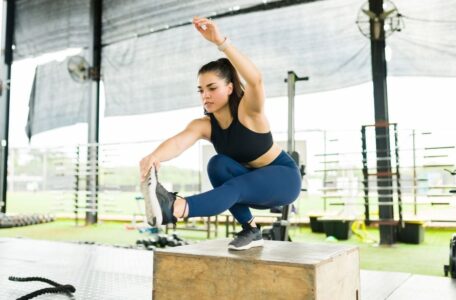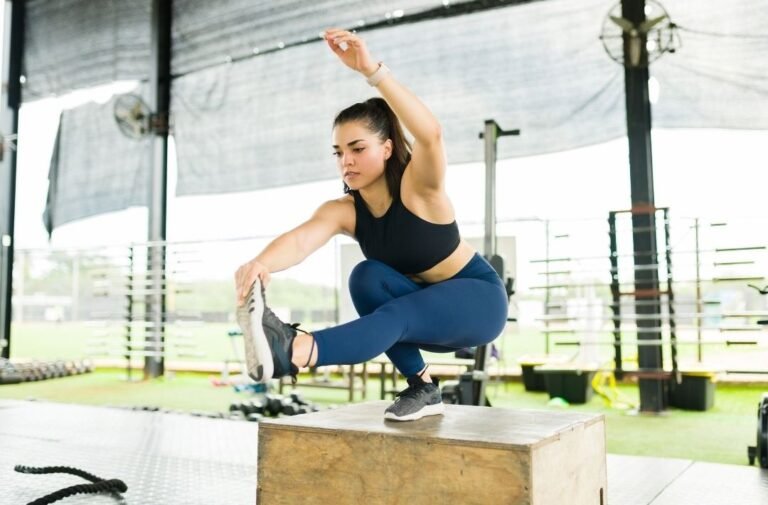First, it looks awesome. Pulling out a pistol squat in the gym makes people stare and wish they could do it. But beyond that, pistol squats have so many benefits that most other leg exercises simply can’t compete with.
It is an extremely challenging exercise that requires very strong leg muscles, a high level of balance and a good degree of flexibility. Because the outside leg is used as a counterweight, you can really work the full range of muscle contraction.
Pistol Squat vs Barbell Back
The barbell back squat, or squat of any nature, is commonly known as the king of exercises. This is still true because of the many benefits it adds to an overall routine.
The back squat allows you to add much more weight due to the greater stability of the exercise, so it can be a great way to build leg strength.
The main problem with back squatting is that as your legs and glutes get stronger, the increased load required adds a lot of weight to your back. This puts a tremendous amount of vertical pressure on your spine, compressing your vertebrae.
If you think about it, your legs and glutes are the strongest muscles in your body – at least they should be unless you skip one too many leg days – so expect your upper body to compensate for the weight required to working them harder and harder can be dangerous without perfect form. It can lead to problems ranging from lumbar and muscle strains to sciatica and bulging or fully herniated discs.
Squat pistols do not have this problem. Doing weighted pistol squats is pretty much the equivalent of back squatting with your own weight added to the bar. When you start adding weight to a pistol squat, there is some pressure on the back, but more from a stabilizing standpoint, and the weight doesn’t need to be as high as it is for a back squat.

The benefits of occupying a pistol
The benefits of the pistol squat are huge. If performed correctly and fully, you will benefit from:
- Isolation of each leg to balance strength deficits
- Full range of muscle recruitment
- Improves the strength of the posterior chain
- Increase overall flexibility and mobility along the posterior chain
- Increases mobility and flexibility of the ankle joint
- Improves balance
- Strengthening stabilizing muscles in the leg
- Improves proprioception through the leg and core
- Eliminates the risk of damaging the spine (compared to the squat)
So when you master the pistol squat, not only will you be giving your legs the best workout they can do, but you’ll be working on a whole lot more.
The added benefit of adding weight is that you don’t need to add a lot to get similar results to adding a lot to the rear. As I mentioned, the pistol squat without any weight is essentially the same as squatting your own body weight.

Weighted Pistol Squats: Increase leg strength
After you’ve mastered the pistol, you can start adding weight by holding something in your hands, like a squat cup. As mentioned earlier, this is a great way to increase the strength required to perform the movement with minimal risk of spinal injury.
For example, I weigh 66kg (I’m a cyclist so I need to be light and have strong legs) and I can pistol squat while holding a 20kg kettlebell. That’s like loading my back with 106-pound weights—almost twice my body weight—and you have to make sure you’re going straight down to the ground with the barbell squatting to match the range of motion.
I will explain further for those who are skeptical. Someone weighing 80 kg squatting twice their weight would need a bar with a load of up to 160 kg. This requires each leg to lift half their body weight (40kg) and half the weight of the barbell (80kg). So each leg technically lifts 120 pounds each. In order for a pistol squat to match this, it would require the leg to lift its entire body weight, which is already 80 pounds, plus the addition of 40 pounds of weight. That leg now works 120 pounds. Carrying a 40kg weight is much less with very little risk of spinal compression. Plus, you get all these added benefits.
It is difficult to compare like to like as there are many factors at play, for example the leverage caused by the extended distance from the center of mass, the fact that the legs have their own weight to consider and the fact that a pistol squat you have the whole other leg to lift. Also, barbell squats require less balance and flexibility, so they can be easier to load.
On a side note, don’t try to match the weight of your barbell straight into a pistol squat (even if the math is taken into account) as you’ll need strong back muscles to stabilize the back, it takes work to build up the extra weight .
After you’ve mastered the pistol squat and are able to add weight, your next method to increase the difficulty is to do a pistol squat on a bosu ball. Then adding weight again.
Pistol squats are a great addition to anyone’s workout, especially if you have issues with back squats, they can be a great substitute. For those who have no problem with the barbell squat, it’s simply a great addition to a solid lower body routine, helping to smooth out any bilateral leg strength deficits. Great if you’ve recently had an accident affecting one leg like me.
Why are pistol squats a good exercise?
It is an extremely challenging exercise that requires very strong leg muscles, a high level of balance and a good degree of flexibility. And because the outside leg is used as a counterweight, you can really work the full range of muscle contraction.
What are the benefits of a pistol squat?
Isolation of each leg to balance strength deficits
Full range of muscle recruitment
Improves the strength of the posterior chain
Increase overall flexibility and mobility along the posterior chain
Increases mobility and flexibility of the ankle joint
Improves balance
Strengthening stabilizing muscles in the leg
Improves proprioception through the leg and core
Eliminates the risk of damaging the spine (compared to the squat)
{ “@context”: “@type”: “FAQPage”, “mainEntity”: [
{
“@type”: “Question”,
“name”: “Why are pistol squats a good exercise?”,
“acceptedAnswer”: {
“@type”: “Answer”,
“text”: “It is an extremely challenging exercise that requires very strong leg muscles, a high level of balance, and a good degree of flexibility. And because of the outward leg being used as a counter balance, you can really work the full range of muscle contraction.”
}
}
, {
“@type”: “Question”,
“name”: “What are the benefits of a pistol squat?”,
“acceptedAnswer”: {
“@type”: “Answer”,
“text”: “Isolation of each leg for balancing strength deficits
Full range of muscle recruitment
Improves the posterior chain strength
Increase general flexibility and mobility along the posterior chain
Increases ankle joint mobility and flexibility
Improves balance
Strengthening of stabilising muscles in the leg
Improves proprioception though the leg and core
Removes danger of damaging spine (compared to back squat)”
}
}
]
}
The post Benefits of Pistol Squats appeared first on Australian Fitness Academy.
